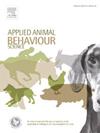How does the previous environment affect pigs’ responses when switching to a barren or enriched environment as assessed by Qualitative Behaviour Assessment?
IF 2
2区 农林科学
Q1 AGRICULTURE, DAIRY & ANIMAL SCIENCE
引用次数: 0
Abstract
Intensive pig farming systems are often characterised by barren and monotonous environments, which can impair pig welfare. While enriching the environment enhances pig welfare, less is known about the implications of changes in housing conditions regularly happening on commercial farms. This study investigated the effect of a previously enriched-varying (E) or barren-monotonous (B) environment on pigs’ behavioural expressions when exposed to a switch of environments from E to B or from B to E as assessed by Qualitative Behaviour Assessment (QBA). QBA is based on the assumption that human observers can integrate subtle details in animals' body language to reflect their affective experience by using descriptors like 'lively' or 'apathetic'. Eight groups of pigs underwent a switch of housing conditions from E to B or from B to E (E*B, B*E), while another eight groups moved to different pens, but with the same conditions (E*E, B*B). Pigs’ behaviour was video recorded 24 h before (PRE) and 24 h after the switch (POST). Using Free Choice Profiling, 14 observers blinded to the PRE-switch housing conditions were asked to score pigs’ behavioural expressions on 64 video clips. Two main dimensions (D1, D2) were identified, which accounted for 65.4 % of the variation. Terms describing dimension 1 (D1) ranged from ‘active/engaged/explorative’ to ‘tired/bored’, while dimension 2 (D2) was characterised as ranging from ‘bored/restless/aggressive’ to ‘relaxed/content/calm’. Against expectation, there was no statistical support for an interaction between PRE-switch and POST-switch condition on pigs’ behavioural expression POST-switch (D1: F1,11 = 0.03, p = 0.86; D2: F1,11 = 0.57, p = 0.47). We cannot disentangle if the PRE-switch conditions did not affect pigs’ behavioural expression POST-switch or if observers did not pick up potential changes, e.g. because the contrasting POST-switch conditions may have masked subtle effects from the PRE-switch conditions. However, even though not statistically supported, the direction of effects was according to hypotheses with E*B groups being more uniformly assessed as reflecting a negative affective state (tired/bored) compared to B*B, while B*E groups were more consistently judged as reflecting a positive affective state (active/engaged/explorative) compared to E*E. To test if this direction of effect is robust, we propose to show video clips of pigs in the same condition POST-switch (either E or B, not both) with different experiences in PRE-switch conditions in future studies. Moreover, future research should provide insight into what changes in housing conditions mean for pigs’ affective states in the longer term.
根据定性行为评估,当猪切换到贫瘠或富饶的环境时,以前的环境如何影响猪的反应?
集约化养猪系统的特点往往是贫瘠和单调的环境,这可能会损害猪的福利。虽然丰富环境可以提高猪的福利,但人们对商业农场经常发生的住房条件变化的影响知之甚少。本研究通过定性行为评估(QBA)研究了先前丰富变化(E)或贫瘠单调(B)环境对猪暴露于从E到B或从B到E的环境切换时的行为表达的影响。QBA基于这样的假设,即人类观察者可以通过使用“活泼”或“冷漠”等描述来整合动物肢体语言中的微妙细节,以反映它们的情感体验。8组猪经历了从E到B或从B到E (E*B, B*E)的猪舍条件切换,而另外8组猪转移到不同的猪舍,但条件相同(E*E, B*B)。实验前24 h (PRE)和切换后24 h (POST)分别记录猪的行为。使用自由选择分析,14名不知道开关前猪舍条件的观察者被要求对64个视频片段中猪的行为表情进行评分。确定了两个主要维度(D1, D2),占变异的65.4 %。描述维度1 (D1)的术语范围从“积极/投入/探索”到“疲倦/无聊”,而维度2 (D2)的特征范围从“无聊/不安/好斗”到“放松/满足/平静”。出乎意料的是,前切换和后切换条件对猪行为表达后切换的交互作用没有统计学支持(D1: F1,11 = 0.03, p = 0.86;D2: F1,11 = 0.57, p = 0.47)。如果切换前条件没有影响猪的行为表达,或者观察者没有发现潜在的变化,例如,因为对比后切换条件可能掩盖了切换前条件的微妙影响,我们无法解开这个问题。然而,尽管没有统计支持,但影响的方向是根据假设的,与B*B相比,E*B组更一致地被评估为反映消极情感状态(疲倦/无聊),而与E*E相比,B*E组更一致地被判断为反映积极情感状态(积极/投入/探索)。为了测试这种方向效应是否稳健,我们建议在未来的研究中展示在相同条件下的猪在转换后(E或B,而不是两者都有)与在转换前条件下的不同经历的视频片段。此外,未来的研究应该能够深入了解猪舍条件的变化对猪的长期情感状态意味着什么。
本文章由计算机程序翻译,如有差异,请以英文原文为准。
求助全文
约1分钟内获得全文
求助全文
来源期刊

Applied Animal Behaviour Science
农林科学-行为科学
CiteScore
4.40
自引率
21.70%
发文量
191
审稿时长
18.1 weeks
期刊介绍:
This journal publishes relevant information on the behaviour of domesticated and utilized animals.
Topics covered include:
-Behaviour of farm, zoo and laboratory animals in relation to animal management and welfare
-Behaviour of companion animals in relation to behavioural problems, for example, in relation to the training of dogs for different purposes, in relation to behavioural problems
-Studies of the behaviour of wild animals when these studies are relevant from an applied perspective, for example in relation to wildlife management, pest management or nature conservation
-Methodological studies within relevant fields
The principal subjects are farm, companion and laboratory animals, including, of course, poultry. The journal also deals with the following animal subjects:
-Those involved in any farming system, e.g. deer, rabbits and fur-bearing animals
-Those in ANY form of confinement, e.g. zoos, safari parks and other forms of display
-Feral animals, and any animal species which impinge on farming operations, e.g. as causes of loss or damage
-Species used for hunting, recreation etc. may also be considered as acceptable subjects in some instances
-Laboratory animals, if the material relates to their behavioural requirements
 求助内容:
求助内容: 应助结果提醒方式:
应助结果提醒方式:


